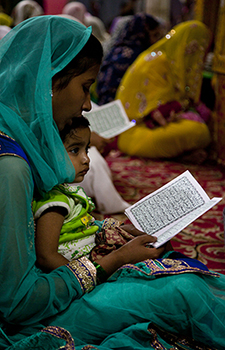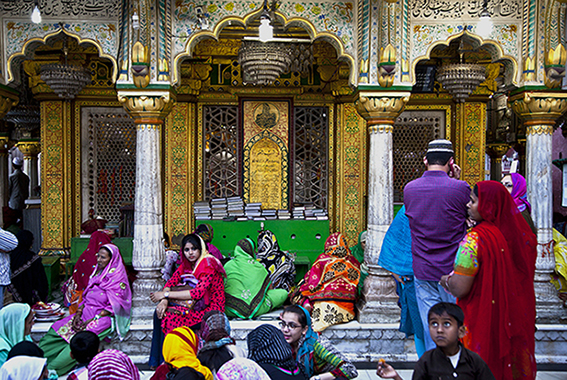With every terrorist attack committed by an Islamist militant in the West, they pop up like mushrooms after rain. The TV pundits and so-called experts making sweeping statements about the true nature of Islam being violent and intolerant. The ignorance of such remarks never fails to amaze me.
How can Islam be inherently violent when it also gave birth to someone like Nizamuddin Auliya, the 13th century Islamic scholar and Sufi saint, whose message of love and compassion still attracts thousands of people to his Delhi tomb every single day?
Hidden by a maze of little alleyways almost exclusively inhabited by butchers and beggars, Nizamuddin’s resting place is one of my favorite places to visit in the Indian capital. Within the walled compound, the crowds and noise of Delhi suddenly seem but a distant memory, while the demands of our modern world make way for a much older reality.
Muslims from all over India flock to this island of tranquility to offer flowers, pray, read the Quran or simply sit in the courtyard to watch life pass by. And not just Muslims. Many Hindus and others come too. Everyone is welcome. Once I saw six transvestites dressed in Indian sarees sitting among the crowds, and no one said a word or raised a finger.
Every afternoon, free meals are handed to the poor. Every evening, a Qawalli band plays and sings in praise of God. It is remarkable how, almost 700 years after his death, Nizamuddin’s spirit is still alive and continues to inspire.
Unfortunately, Nizamuddin is not well-known outside India. In fact, his name is no longer widely familiar in India either, as the Hindu nationalists currently in power on the one hand tend to glorify the nation’s Hindu past, while on the other they downplay and vilify the country’s Buddhist and Muslim eras.
That is unfortunate, for Nizamuddin was an extraordinary man who led by example and whose teachings deserve a wider audience, especially in today’s increasingly polarised world.
Under the soothing shadow

The accounts of Nizamuddin’s early life vary slightly, but most claim he was born in 1238 in Badayun some 220 kilometres east of Delhi. His parents had fled Bukhara in Central Asia a few years before Genghis Khan and his Mongol army ransacked and destroyed the ancient city in 1220.
He was only five years old when his father died. According to Khadiq Ahmad Nizami’s biography, Nizamuddin grew up in poverty, yet was a gifted student. By the age of 16, he had learnt the Quran by heart and moved to Delhi to continue his studies in Fiqh (Islamic jurisprudence) and the Hadith (sayings attributed to the Prophet Mohammad).
Delhi at that time was the capital of the Delhi Sultanate, which had absorbed many of the Muslims fleeing the Mongol onslaught and would control northern India for over 300 years. By the age of 20, Nizamuddin became a disciple of the Sufi saint Farid Shakarganj who, three years later, made him his successor.
Sufism is generally described as the inner or mystical dimension of Islam. In addition to observing the outer pillars of Islam, a Sufi aims to achieve a state of moral and spiritual perfection by overcoming worldly desires and “worshipping God as if you see him”.
To do so, Nizamuddin established a khanqah, a centre for religious and spiritual guidance on what is today the site of his tomb, which 700 years ago was situated well outside Delhi’s city walls. Gradually, more and more people visited and Nizamuddin took on disciples, many of whom would become respected scholars in their field of expertise.
Like him, they were dressed in simple white garments and permanently lived in the centre. They would not just pray, meditate and study. According to Nizamuddin, a truly religious man should put himself in the service of mankind by taking care of the needy and destitute.
Solace through the ages
 Furthermore, to achieve spiritual purity, Nizamuddin believed one had to stay far from any form of material wealth and attachment. Hence, no regular payment, only futuh (unrequested gifts) were accepted, which were used for the general benefit of the khanqah, where every visitor was offered a free meal.
Furthermore, to achieve spiritual purity, Nizamuddin believed one had to stay far from any form of material wealth and attachment. Hence, no regular payment, only futuh (unrequested gifts) were accepted, which were used for the general benefit of the khanqah, where every visitor was offered a free meal.
For the same reason, Nizamuddin’s disciples were not allowed to accept any form of stipend, grant or employment from the government, as such a worldly attachment would jeopardise their role as a spiritual guide.
No less than 13 rulers sat on the throne of the Delhi Sultanate during Nizamuddin’s lifetime, yet he never set a foot in court. The royal family, like anyone else, was welcome to visit him.
Nizamuddin’s seemingly only frivolous delight was poetry and Qawalli music, which he deemed accepted art forms as they were able to bring the listener closer to God.
Not surprisingly, Nizamuddin was a hugely popular figure during his life and remained so after his death in 1325. For centuries to come, Delhi nobility wished to be buried in his shade, including the mighty Mughal Emperor Humayun, who died more than 300 years later. His mausoleum stands just around the corner of Nizamuddin’s tomb.
And so even Humayun, who ruled half the world in the name of Islam, eventually found solace in the presence of Nizamuddin, the great and gentle soul who embraced all of mankind in the name of Islam.
MIDDLE EAST EYE Sept 26,2016
Text/ Image Peter Speetjens
